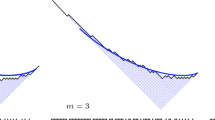Abstract
We formulate a new method of performing high-temperature series expansions for the spin-half Heisenberg model or, more generally, for SU(n) Heisenberg model with arbitrary n. The new method is a novel extension of the well-established finite cluster method. Our method emphasizes hidden combinatorial aspects of the high-temperature series expansion, and solves the long-standing problem of how to efficiently calculate correlation functions of operators acting at widely separated sites. Series coefficients are expressed in terms of cumulants, which are shown to have the property that all deviations from the lowest-order nonzero cumulant can be expressed in terms of a particular kind of moment expansion. These “quasi-moments” can be written in terms of corresponding “quasi-cumulants,” which enable us to calculate higher-order terms in the high-temperature series expansion. We also present a new technique for obtaining the low-order contributions to specific heat from finite clusters.
Similar content being viewed by others
Reference
G. S. Rushbrooke, G. A. Baker, Jr., and P. J. Wood, in Phase Transitions and Critical Phenomena, C. Domb and M. S. Green, eds. (Academic, London, 1974), Vol. 3, p. 245.
J. Oitmaa and E. Bornilla, Phys. Rev. B 53:14228(1996).
M. P. Gelfand, R. R. P. Singh, and D. A. Huse, J. Stat. Phys. 59:1093(1990)
M. P. Gelfand and R. R. P. Singh, Adv. Phys. 49:93(2000).
N. Fukushima and Y. Kuramoto, J. Phys. Soc. Jpn. 71:1238(2002).
R. Kubo, J. Phys. Soc. Jpn. 17:1100(1962).
For this purpose, an extrapolation of the FCM result and a direct calculation of a few leading orders have been done: A. Bühler, N. Elstner, and G. S. Uhrig, Eur. Phys. J. B 16:475(2000)
W. O. Putikka, M. U. Luchini, and R. R. P. Singh, Phys. Rev. Lett. 81:2966(1998).
D. C. Handscomb, Proc. Camb. Phyl. Soc. 60:115(1964).
H. H. Chen and R. K. Joseph, J. Math. Phys. 13:725(1972).
P. Fulde, in Electron Correlations in Molecules and Solids (Springer-Verlag, 1995), p. 82.
C. Domb, in Phase Transitions and Critical Phenomena, C. Domb and M. S. Green, eds. (Academic, London, 1974), Vol. 3, p. 1.
Author information
Authors and Affiliations
Rights and permissions
About this article
Cite this article
Fukushima, N. A New Method of the High Temperature Series Expansion. Journal of Statistical Physics 111, 1049–1090 (2003). https://doi.org/10.1023/A:1023091930271
Issue Date:
DOI: https://doi.org/10.1023/A:1023091930271




